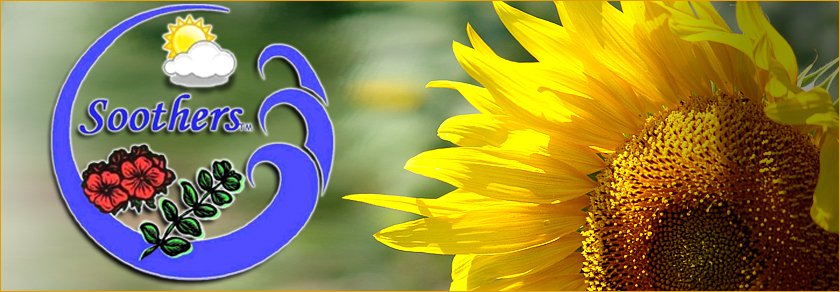
INFORMATION
Aromatherapy
The positive effects of certain olfactory stimulants have been shown to bring about measurable positive effects on the limbic
system and the brain—the seat of memory and emotion. Essential Oils have amazing healing properties and are absorbed both
by smell and osmosis when applied on the skin via carrier oils, creams, or lotions. Keep out of the reach of children and pets.

|
Introducing Aromatherapy
In times past, certain fragrant plants were found to heal the body. They were either ground into a powder and placed in a snuff box or made into small bouquets. Essential oils were found to enhance the mind, body, and spirit, and also turned out to be effective for many different kinds of treatments.
Aromatherapy goes as far back as 7000 BC, when the Egyptians used essential oils in to preserve mummies. When King Tutankhamen's tomb was discovered in 1922, an ancient calcite pot in his burial chambers gave off the fragrance of Frankincense when it was opened. More recently, when a forensic scientist unwrapped the bandages of a 3,000-year-old mummy, a strong aroma of Myrrh and Cedarwood was noted. Essential oils were not only used during mummification but were burned as fumigants, used as medicines, or blended into perfumes and cosmetics in ancient times.
Egyptians practiced primitive forms of steam distillation using pots of clay. They produced several kinds of aromatic extractions such as Cinnamon, Cedarwood, Frankincense, Myrrh, Juniper, and Calamus. Some of the work of the ancient Egyptian aromatherapists have lasted to this day. Cleopatra used the aromas of Roses and Orange Blossoms to woo Marc Antony. Even the sails on her ships were infused with these aromas so that a cloud of scent followed her wherever she went.
The Greek and Roman cultures used essential oils for many of the same purposes as the Egyptians, as has been found in numerous excavations. The Greeks loved aromatic plants and would spread fragrant herbs, such as mint leaves, on their temple floors. Hippocrates recommended aromatic baths and massage to prolong life.
Victorious Romans were awarded laurel crowns after winning competitions. Garlands and crowns of mint and rosemary commemorated important occasions and victorious battles. The Romans were famous for their scented baths and fragrant massages. It’s believed that the name of the lavender plant came from the Latin “lavare--to bathe."
The Bible has 100 references to various essential oils. In Matthew 26:6, and Mark 14: 3, the Bible tells how a woman anointed Jesus' head with an expensive perfume that filled the house with the scent of Spikenard; in John 12: 3, Mary poured pure Spikenard on Jesus’ feet and dried them with her hair. The gifts from the Magi to the Christ child: Gold, Frankincense and Myrrh have been interpreted to represent life, death, and rebirth.
The Black Plague in the 17th century killed over a third of the population of Europe. The stench of decomposing dead bodies was everywhere. People believed that the smell had the disease in it, and so balls of pomander and herbal nosegays were used to cloak the unpleasant smells. The men used hollowed-out walking sticks filled with Aromatic substances. French doctors wore head-to-toe leather cloaks. They protected their faces with grotesque beaked masks. Aromatic herbs were placed inside the bird-like beak to protect them from infection. This strange attire is believed to be the source of the term “Quack” in reference to incompetent doctors. London perfumers and glove makers used essential oils to scent their gloves and assured purchasers that this would help them to remain immune to the plague. Because the town of Buklesbury, England, was spared from the Plagues, it was attributed to the fact that it was the center of the lavender trade.
A French scientist, Rene-Maurice Gattefosse, had his first encounter with aromatherapy while researching the healing properties of essential oils and their antiseptic and cosmetic abilities. He was injured in a laboratory explosion that resulted in severe burns to his hand. In intense pain, he grabbed a beaker of full-strength Lavender oil and drenched his burned hand with it. To his surprise, the lavender oil took the sting out of his burn, his skin healed very quickly, and there was no scar.
Advancing the science of aromatherapy, another Frenchman, Dr. Jean Valnet, during a severe shortage of drugs in World War II, successfully used essential oils to treat wounded soldiers. Later, he utilized essential oils to wean long-term psychiatric patients off their chemical drugs. Today, the use of essential oils, known as True Aromatherapy, is becoming more common. |

HOW AROMATHERAPY WORKS
Aromatherapy is based on the natural fragrances of essential oils that enhance healing and soothe the emotions. Most of them may be applied to the skin for absorption into the tissues of the body to promote healing. The term, “neat” means that the oil in question does not need to be diluted and will not harm the skin (e.g., lavender). Some oils have to be blended with carrier oils to dilute their intensity, so that they will not cause a rash, burning, or drying.
The essential oils of aromatic plants, such as chamomile, lavender, lemon balm (aka melissa), and eucalyptus are extracted by means of a steamed distillation process, in which the resulting essential oils are at least 50 times more potent than the plants
from which they are taken. It takes about 100 pounds of fresh herbs to make one pound of essential oil.
Some Essential oils are “volatile,” which means that they can quickly evaporate into the air. Diffusers emit a cloud of fragrance
that the sinus cavities can absorb immediately. The inhalation process is superior to taking herbal supplements in capsule form, since a very small quantity of essential oil goes a long way.
Upon inhaling the diffused essential oils, the limbic system recognizes the pleasant scent, and the brain responds to it with
feelings of relaxation and pleasure. It can affect the subconscious as well as the conscious mind. For instance, when we
smell spoiled food, our brain immediately recognizes the danger to the body and we throw it away; perhaps you have
experienced a certain smell that reminds you of a wonderful feeling or place. Pure essential oils are best for inhalation
and skin applications results. |

What are Aromatherapy and Aromachology? |
Aromatherapy is the all-natural way of treating the body, mind, and spirit with natural aromatic substances that are harvested from
nature. "Aroma" refers to substances that give essential oils their characteristic odor or smell. "Therapy" refers to the fact that essential oils have been used in healing for centuries. Aromatherapy also refers to the use of essential oils for beauty and body treatments. Aromatherapy is one of the most popular beauty treatments in clinics and spas throughout Europe and the Americas.
Aromatherapy by means of essential oils in some countries is part of their medical practices. Pure, unadulterated essential oils can be used in many ways to alleviate a number of physical problems and provide a healthier environment in the home. The study of psychology as it relates to odors is sometimes referred to as Aromachology. Aromatherapy and Aromachology differentiate the science, study, and theory of aromachology from the application by clinicians and aromatherapists.
Essential Oils at Work
Essential oils have certain natural balancing effects. The correct application can instigate a reaction in the body to achieve a state of homeostasis or balance. Essential oils can affect the autonomic nervous system, the endocrine system, blood pressure, and hormone balance, as well as other body systems. Essential oils respond to the human body’s need at any given time. For instance, if the body is worn down and sluggish, essential oils can effect stimulation. Essential oils work as phytohormones. The molecules mimic some of the natural hormones and act as messengers or keys to the related systems of the body.
Mixing two or more essential oils together creates a chemical compound oil that is different from any one of the component oils.
Properties of Essential Oils
Each essential oil has its own therapeutic properties and uses. Various essential oils have antibacterial, antifungal, antiseptic,
anti-inflammatory, anti-neuralgic, anti-rheumatic, anti-spasmodic, anti-infectious, anti-parasitic, diuretic, anti-venomous, anti-toxic, antidepressant, sedative, nervine (related to many nervous disorders), analgesic (reduces pain), hypotension, digestive,
expectorating, deodorizing, granulation stimulating, circulatory stimulating, and diuretic qualities. |

What Essential Oils Do
Anise Seed – antispasmodic, aphrodisiac, digestive, diuretic, expectorant, insecticide, laxative, and stimulant.
Bergamot - analgesic, anaesthetic, anti-depressant, anti-inflammatory, anti-spasmodic, anxiety relief, flatulence, cicatrisant, deodorant, depression, digestive aid, expectorant, febrifuge, insomnia, insecticide, sedative, stress, stomachic, tonic, vermifuge, and vulnerary.
Cedar Wood – antiseptic, astringent, diuretic, expectorant, fungicide, insecticide, and sedative.
Cinnamon– anesthetic, antiseptic, antispasmodic, astringent, insecticide, parasiticide, and stimulant.
Citronella– antidepressant, antiseptic, deodorant, insecticide, parasiticide, and stimulant.
Clove Bud– analgesic, anesthetic, antispasmodic, aphrodisiac, disinfectant, insecticide, and stimulant.
Eucalyptus - analgesic, antiseptic, antispasmodic, antiviral, bactericide, balsamic, decongestant, deodorant, diuretic, expectorant, insecticide, and stimulant.
Geranium - analgesic, anticoagulant, antidepressant, and insecticide.
Pink Grapefruit - antidepressant, antiseptic, diuretic, disinfectant, and stimulant.
Lavender – analgesic, antidepressant, antiseptic, antispasmodic, antiviral, bactericide, burns, decongestant, deodorant, detoxicant, diuretic, fungicide, restorative, and sedative.
Lemongrass – antidepressant, antiseptic, bactericide, deodorant, digestive, diuretic, fungicide, insecticide, and stimulant.
Lime - antiseptic, antiviral, astringent, bactericide, disinfectant, insecticide, and restorative.
Sweet Orange - antidepressant, antiseptic, antispasmodic, digestive, and sedative.
Patchouli - antidepressant, antiseptic, aphrodisiac, astringent, deodorant, diuretic, fungicide, insecticide, and sedative.
Peppermint - analgesic, anesthetic, antiseptic, antispasmodic, and astringent.
Pine - antiseptic, balsamic, decongestant, expectorant, restorative, and stimulant.
Rosemary - analgesic, antidepressant, antiseptic, antispasmodic, astringent, digestive, diuretic, and stimulant.
Sage Clary - antidepressant, antiseptic, antispasmodic, astringent, balsamic, deodorant, digestive, and sedative.
Tea Tree – (also known as melaleuca oil) antibiotic, antiseptic, antiviral, bactericide, balsamic, expectorant, fungicide, insecticide, and stimulant.
Wintergreen – antispasmodic and anti-inflammatory.
Ylang Ylang - antidepressant, antiseptic, aphrodisiac, and sedative.
|
|
Please Note: Essential oils are pure,100% essential oils. Do not swallow essential oils,
or apply directly to skin, or put in eyes, nose, or ears. Keep out of the reach of children.
Essential oils can be harmful and even fatal to pets; do not apply them to
your pet unless under the supervision of a Certified Aromatherapist, M.D., or Veterinarian.)
|
 |
Essential Oils with amazing properties
Essential Oils with Anti-Viral Properties:
Allspice, Anise, Balsam Fir, Bergamot, Black Pepper, Blue Camphor, Cassia, Cajuput, Cinnamon, Clary Sage, Clove, Cypress, Elemi, Eucalyptus, Geranium, Garlic, Helichrysum, Juniper, Labdanum, Lavender, Lemon, Lemongrass, Lime, Melissa- (aka Lemon Balm), Myrrh, Niaouli, Onion, Oregano, Palmarosa, Patchouli, Peppermint, Pine, Ravensara, Rosemary, Sandalwood, Sage, Tarragon, Tea Tree-(also known as Melaleuca), and thyme.
Essential Oils with Antibacterial Properties:
Bay Laurel, Bergamot , Black Pepper, Cajuput, Cassia , Chamomile, Cinnamon, Clove Bud , Cypress, Eucalyptus, Grapefruit, Lavender, Lavender Spike, Lemon, Lemongrass, Lime, Marjoram, Niaouli, Oregano, Palmarosa, Patchouli, Peppermint, Pine, Ravensara, Rosemary, Sage, Sandalwood, Tea Tree-(also known as Melaleuca), and Thyme.
Essential Oils with Anti-inflammatory Properties:
Bergamot, Black Pepper, Basil, Blue Tansy, Clary Sage, Citronella, Coriander, Cypress, Elemi, Fir, Frankincense, Geranium, Helichrysum, Hyssop, Jasmine, Lavender, Lemongrass, Lime, Litsea, Melissa- (aka Lemon Balm), Mountain Savory, Myrrh, Orange, Oregano, Peppermint, Pettigrain, Pine, Rose, Sage, Sandalwood, Spikenard, Spearmint, Tarragon, Tea Tree-(also known as Melaleuca), Thyme, Valerian, Verbena, Yarrow, Ylang Ylang, and Wintergreen.
Essential Oils with Antiseptic Properties:
Basil, Bergamot, Cinnamon, Clary Sage, Clove, Eucalyptus, Fennel, Lavender, Lemon, Pine needle, Rosemary, Sage,
Tea Tree-(also known as Melaleuca) and Thyme.
Essential Oils with Anti-Fungal Properties:
Cedarwood, Eucalyptus, Lavandin, Lavender, Lemongrass, Myrrh, Oregano, Sage, Savory, Tagetes, Tea Tree-(also known as Melaleuca), and Thyme. |

DOs & DON’Ts for your Essential Oils
Avoid evaporating, spilling, contaminating, or breaking the bottle. Store them correctly in a dark, cool place
away from heat, cold, pets, and children in order to get the greatest benefit from your oils. Both essential
and carrier oils should be kept at a constant temperature to maintain their strength and healing properties.
If you keep them in a storage container, wood is best, although some folks use fishing tackle boxes.
Never leave oils in direct sunlight. This will eventually make the bottle explode. Essential oils perform best
if packaged in dark colored glass (dark amber, blue, green, or violet) to protect them from ultra-violet rays. Bottles are designed to stand upright and should not be laid down on its side. Prop them up if necessary to prevent leakage or corrosion of the rubber portion of the dropper (which will contaminate the oil).
 |
 |
Check your oils often. If they look cloudy or have particles floating around in them, they are contaminated, and you will have to throw them away.
If you re-use your pipettes or droppers, make sure they are thoroughly cleaned in hot, soapy water. Rinse with hot water. Make sure that they are totally dry before use, since tap water has bacteria and chemicals in it that can alter and contaminate your oils.
Never use the same pipette or dropper for different essential oils. Used pipettes can be stored for a short time in clip-seal plastic bags to use again later. Avoid contaminating the essential oil. Don't touch the inside of the lid or the rim of the bottle. If you are using pipettes for your essential oils, it is best to throw them away after each use.
Wear sterile gloves and protective safety glasses when handling essential oils. Keep all essential oils and carrier oils out of the reach of children and pets. Essential oils are concentrated; they can make a child or pet sick if ingested.
Citrus essential oils are the most volatile and evaporative. To avoid evaporation, store them in the refrigerator or in a cool place. Some chilled essential oils might solidify and you will need to let them warm up to room temperature before use. Volatile essential oils that evaporate quickly need to be tightly capped when you are not using them. Citrus oils have the shortest shelf life (grapefruit, orange, lemon, lime, and tangerine). When these oils turn cloudy or smell rancid they need to be thrown away.
Most essential oils are flammable and can act as strong solvents; therefore, never leave them near a source of ignition, such as cookers, fires, candle flames, or any other flame. Store them safely and securely. Pure eucalyptus oil, for instance, can be used to remove glue or to strip paint.
Under no circumstances should you ever place undiluted essential oils in a plastic bottle. Most essential oils will eat and melt plastic and rubber. Diluted essential oils, such as massage oils and lotions, are safe in plastic because the concentration of essential oil is much lower.
Essential oils can be stored for periods from six months to several years. Some oils, like myrrh, sandalwood, frankincense and patchouli, will "mature" with age, and become better in a way similar to wine.
Ceramic Diffusers and oil lamps need only 2-6 drops of essential oil per room. The well on the oil lamp should be filled with clean water almost to the rim and then add the 2-6 drops of essential oil. Light the candle in the burner carefully. Some essential oils are flammable, so take care when you are using an essential oil lamp or ceramic diffuser.
Bear in mind that pure therapeutic oils (essential oils) are far more effective than synthetic oils (Fragrance Oils). Synthetic oils can be harmful if applied to the skin or their mist inhaled at full strength.
Because you might have allergies or other negative reactions to some blended mixtures, always perform a patch test with any product that is to be applied to the skin. Test on the inside of your elbow or behind your
ear lobe for 24 hours. If there is a reaction, then do not use the product. Also do this with carrier oils. Pure Essential Oils are natural and have no preservatives or additives. Some can be dangerous if not handled carefully.

DOs & DON’Ts for your Base Carriers and massage oils
Carrier oils are used to dilute essential oils because some essential oils can irritate the skin. Carrier oils lubricate the skin, which is beneficial for massage purposes. They deliver, or carry, the essential oils through the surface tissues of the body by osmosis. Carrier oils don’t evaporate, and most of them have no aroma, while ssential oils do. The different carrier oils have different properties. Choose any carrier oil that will
enhance the essential oil’s benefits. Sweet Almond Oil, Apricot Kernel Oil, Avocado Oil, Borage Seed Oil, Evening Primrose Oil, Fractionated Coconut Oil, Grapeseed Oil, Jojoba Oil, Macadamia Nut Oil, Neem Oil, Olive
Oil, Rose Hip Oil, Safflower Oil, Sunflower Oil, and Sesame Oil.
Most carrier oils will solidify to a butter-like consistency at cool temperatures if they have not been refined.
The essential fatty acids need to be removed from the oils in order for them to remain in the liquid state.
Vegetable oils sold in grocery stores are not cold-pressed cosmetic grade. Grocery store oils are processed
with heat. Your local health food/nutrition store may sell carrier oils. Carrier oils are a bit more expensive because they are cosmetic grade, but they offer a combination of therapeutic properties for the skin. Carrier
oils are vegetable oils extracted from the fatty portions of plants, seeds, kernels or nuts.
What is the term phototoxicity?
Phototoxicity is the result of exposure of the skin to the sun from Citrus essential oils such as, bergamot, lime, angelica, lemon, orange, and grapefruit. When you spray one of these essential oils on your skin, and then go out in the sun for long term exposure, you can also get some serious burns to your skin. |

WHAT ARE BASE AND CARRIER OILS?
Base and Carrier oils dilute the intensity of some Essential oils that could cause irritation to the skin. They have no scent. Essential oils retain their scent when mixed with a base or carrier oil. Some Essential oils may be used directly on the skin, such as Lavender, but others can dry or burn the skin in full strength form (e,g, Tea Tree oil). Before using essential oils, it is best to perform a skin patch test, in which you apply a small drop of the essential oil to the inside of your elbow or behind the ear. Then wait 24 hours to see if the skin has a reaction to it. This test can also be done with Base and Carrier oils.
There are many kinds of bases and carrier oils that come in cosmetic grade for topical use on the skin. The bases include Water, Witch Hazel, Aloe Vera and butters which are considered heavy oils. Carrier Oils include Neem, Sweet Almond, Sesame, Evening Primrose, Coconut, Flaxseed, Sunflower, Hazel Nut, Foraha/Tamanu, Cocoa Butter, Shea butter, Palm, Olive, Safflower, Macadamia, Peanut, Rose Hips, Kukui Nut, Oyster Nut, Rapeseed, Grapeseed, Soybean, Jojoba, Wheat Germ, Apricot Kernel, Castor, Carrot Seed, Mango butter, Glycerin, Corn, Mineral, Avocado, Borage Seed, Canola, and many more.
The Following are used most often:
Water- used as a carrier for baths and foot soaks. Water is the best carrier for a long term soak.
Aloe Vera- Has healing properties all its own for burns, irritations, and raw open wounds.
Sweet Almond Oil- Good for all skin types. Generally used for dryness, soreness, itching, and inflammation, and contains minerals, vitamins and proteins.
Sunflower Oil– Good for all skin types. Generally used for dryness, soreness and inflammation. Leaves a satiny, smooth, non-greasy feel. It contains Vitamins A, B, D, and E, and has a high lineolic acid content. It has both protective and healing effects on the skin. It
also has a natural sunscreen effect on the skin. Used for leg ulcers, bruises, skin problems, and circulation.
Safflower Oil- High in polyunsaturated fatty acids. Used for circulatory problems, asthma, painful joints, sprains, and bruises.
Grapeseed Oil- For skin types that don't absorb oils very quickly. A natural Vitamin E and F antioxidant, with an anti-aging effect.
Jojoba Oil- From the Jojoba Bean. A liquid wax base oil similar to natural secretions produced by the skin. Jojoba oil has antioxidant properties. It keeps skin and hair moisturized and nourished for long periods of time. Also high in Vitamin E and collagen. Good for all skin types.
Apricot Kernel Oil- Properties similar to Sweet Almond Oil. Great for facial use. For skin types that don't absorb oils very quickly. Great for mature skin.
Fractionated Coconut Oil- Saturated fatty acids absorbs quickly, without staining. Can be sprayed directly on skin. Is non-greasy, leaves skin silky smooth. Good for all skin types.
Witch Hazel- Natural astringent and anti-inflammatory for all skin types. Has 14% alcohol content.
Lotions and Creams- Essential oils can be added into any Lotion or Cream that you like to use, preferably compounded from natural substances. |

Essential Oil Ideas
1. Add 8 drops of Lavender Essential oil to a 2 oz. spray bottle of distilled water. Shake well and spray your pillowcases before you put them in the drier or iron them. You can also try this with your choice of Essential Oil on your clothes.
2. Add 4 to 8 drops of any essential oil to an Aroma Brass (or ceramic) ring placed on a cold light bulb. It will diffuse into the air whenever the light is turned on.
3. Add 4 to 8 drops of any essential oil to the water in the well of the ceramic candle diffuser. Stir to mix the oil and water, then light the candle and enjoy the aroma.
4. Make your own scented potpourri. Add 4 to 8 drops of Essential Oil and a teaspoon of witch hazel to a one-ounce spray bottle filled with distilled water. Spray over the potpourri mix and enjoy the aroma.
5. To eliminate odors in the kitchen, add 10 to 15 drops of Essential Oil to a pan of simmering water. The aroma in your house will be delightful.
6. Make your own carpet deodorizer with baking soda and your favorite essential oil. Mix the same way as for potpourri (in No. 5). Don't saturate the soda too much, or it will melt away.
7. Put a few drops on your vacuum bag each time you change it. It will smell fresh, even where it is stored.
8. Place a few drops in all your trash cans before you insert the plastic bag.
9. Place some Essential Oil drops on a clean rag or washcloth and place it in the dryer with your clothes.
10. Add some to the inside of the toilet paper roll.
11. To make your own perfume, fill a bottle ¾ of the way with your choice of carrier oil and add 1 drop of frankincense, 2 drops Lavender, and 3 drops of another favorite Essential Oil to make your own perfume.
12. For the car, put two or three drops on a cotton ball and place it in the open ash tray or place the side of the cotton ball that has no oil on it on the dash in the sun. When you come back to the car you can smell the pleasant aroma. |
“Diffusers, how do we use them?” |
Oil Burner Diffusers with candles –
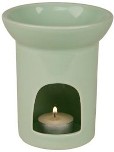 |
This kind of burner has a place at the bottom for a tea light candle and on the top is a well where
you put water and place 4 to 6 drops of your favorite Essential Oil. Light the candle and the heat
from the flame makes the aroma fill the room. Keep an eye on the flame. When it goes out there
might still be oil and water in the well. Clean the well so that it will be ready for the next use.
This kind of Diffuser comes in many sizes and shapes made of glass, ceramic and metal.
|
|
|
|
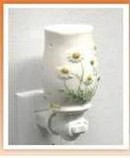 |
On the top is a well where you add water and place 4 to 6 drops of your favorite Essential Oil. The
light bulb generates sufficient heat to diffuse the essential oil. It is similar to the tea light candle,
but without the live flame. It will usually last most of the night. In the morning, if there is still oil
and water in the well, clean it thoroughly so that it will be ready for the next use. This diffuser
has a rotating lock plug in its base to fit any outlet and comes in four different designs. |
|
|
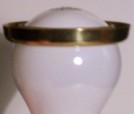 |
This diffuser is to be used with a 40 to 60 (maximum) watt bulb. Take care not to burn yourself
on the brass ring while it is hot. There are ceramic versions, but some prefer brass because it
seems to diffuse more effectively. Put water in the ring depression and add 4 to 6 drops of your
favorite Essential Oil, then carefully place it on the light bulb while the bulb is turned off. Make
sure that none of the water gets on the light bulb--it could shatter the bulb and cause injury. |
|
|
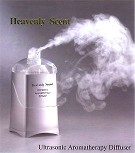 |
This diffuser also is a humidifier and ionizer. It is easily portable. You can take it to the
office or place it in any room. It has a inner plastic cup-like well that you fill with water
and then add 4 to 6 drops of your favorite Essential Oil. You need to keep this one very
clean and check the cups to make sure there are no leaks. Additional cups are included. |
Car Lighter plug in Diffuser - |
 |
This diffuser plugs into your car cigarette lighter. Place 4 to 6 drops of your favorite Essential Oil
on the little card, slide it into the slot and plug the device in to your lighter. It runs off the car battery.
It will freshen the air in your car. Replacement cards are necessary if you want to change your scent. |
|
|
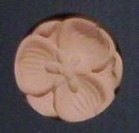 |
These have a Velcro attachment. You can place them on the dash of your car, or even in
the rear window area if your dash is not Velcro-friendly. Place 4 to 6 drops of your favorite Essential Oil
on the ceramic disc. The sun works as the heater to diffuse the Essential Oil. Your car will smell great. |
|
|
 |
Reed diffusers are popular this year. It is a “Set-it-and-Forget-it” Diffuser, but when
you are not able to smell the aroma any more, it is time to refresh the mixture and wipe dust off
the reeds. The reeds can be re-used, but eventually you will have to throw them away and start
with fresh ones. They usually come with Essential Oil or fragrance of some kind, but you can
get them plain and add your own Essential Oil mixture. When you don’t use them the cork-lid
will prolong the scent and keep the dust out. The smaller the room the less reeds you need. |
Also try our "Diffuser Oils" in any diffuser
There are many kinds of diffusers out there. These are just a few of them. But they
are a wonderful way to diffuse and enjoy Essential oils for your mind, body, and soul.
|

Precaution:
Always consult an Aromatherapist regarding the use of essential oils, and tell your Physician that you
are using essential oils. Take care and use caution in the application of all products. They are absorbed
through the skin. Essential oils for use on the skin need to be diluted with a base and/or carrier oil.
There is no scientific evidence for the belief that epileptics should avoid Camphor, Fennel, Hyssop, Sage,
Rosemary, Birch, or Wintergreen. However, pregnant women should avoid Origanum, Peppermint, Rose,
Rosemary, Sage, Thyme, Wintergreen, or Birch for at least the first three months of their pregnancy,
unless under the care and guidance of an Aromatherapist and Physician.
Test all products on inside of elbow or behind the ear lobe for 24 hours. If allergic reaction occurs discontinue use. All
cream and oil products are for external use only. Do not put in eyes or mouth. Keep out of the reach of small children.
("Essential oils can be harmful and even fatal to pets. Do not apply them to your pet
unless under the supervision of a Certified Aromatherapist and / or Veterinarian.")
(All creams and Oil products from Soothers can be applied to skin, feet, hands, face and meridians.)
|

Ingredients
|
Aloe Vera - a succulent plant with healing properties. The pulp of the leaves may be used for antibacterial, anti-inflammatory, and moisturizing. It enhances healing for burns and other skin conditions. There are no known side-effects.
Apricot Kernel Oil - carrier oil and natural moisturizer for skin types that cannot absorb oils efficiently. Good for mature skin.
Bees Wax - a natural wax manufactured by bees for cells where they store honey (honeycomb).
Calciferol - part of Vitamin D -- promotes healthy skin.
Carboner - a white powder, lightly acidic, used as a thickener for both water and oils in cosmetics. A low volume is recommended for sensitive skin. High volumes are utilized in gel formulation processes.
Castor Oil - cosmetic grade natural vegetable oil from castor beans. Used to bind ingredients that include water in cosmetics. Creates a sticky feeling on the skin, but soothes skin irritations. Used in bath oils, perfumes, cosmetic face masks and lipsticks.
Cetheth-20 - derived from vegetable oil, used as a thickening agent in cosmetics to stabilize mixed ingredients.
Cetyl Alcohol - solid organic compound that was one of the first alcohols to be isolated from vegetable oils such as palm oil and coconut oil.
Coconut Oil (plain and / or Bleached and Deodorized) - natural saturated fat extracted from coconuts.
Used in soap, shampoos conditioners, and lotions. Helps promote lather as a cleansing agent. Beneficial to skin.
Colloidal Silver - actual silver atomized in solution. Considered a natural mild antibiotic and antiviral.
Deionized Water - water that has had particles and components that interfere with stability and performance of cosmetics filtered out.
Dimethicone - a fine silicone 'sand' with unique fluid properties. It gives a smooth, silky feel on skin. An effective emollient. Used to reduce scarring and to heal wounds.
DMDM Hydantoin - cosmetic grade of formaldehyde used as a preservative. Used in low volumes for cosmetic products.
Essential oils - oils extracted from whole fragrant and / or aromatic harvested bulk herbal plant material by a process of distillation. They have natural medicinal and healing benefits.
Grapeseed Oil - carrier oil, with natural Vitamins E and F--antioxidant and Anti-aging effect.
Green Tea - herbal tea with healing and longevity properties.
Glycerin - natural cosmetic grade vegetable plant extract used as a cosmetic emulsifier and moisturizer.
Herbs - natural, safe, edible, and suitable for topical application to the body for a wide variety of ailments.
Hydroxyethcellulose - a by-product of corn, which is used as a binder in many cosmetics, makeup foundations, shampoos, mascaras, hair rinses, tanning products and lotions.
Jojoba Oil - extracted from the Jojoba plant, it is a carrier oil, natural sunscreen, antioxidant, and has healing and moisturizing effects on skin; high in Vitamin E and collagen.
Lake Salts - naturally occurring in saline bodies of water.
Methylparaben - wood alcohol and benzoic acid, found naturally in cherry bark, raspberries, tea, anise, and cassia barks.
Natural Coloring - cosmetic grade, similar to food coloring.
Palm Oil - natural plant extract from palm butter. Used in baby soaps, soaps, salves, and ointments.
Panthenol - Vitamin B5.
Propylparaben - preservative against bacteria and fungus. From benzoic acid, it is found naturally in cherry bark, raspberries and tea.
Propylene Glycol - cosmetic grade humectant, used to retain moisture. Is in foundations, deodorants, hair spray mascaras, baby lotions, mouthwashes, and lipsticks.
Water - natural water that is filtered and distilled to remove any chemicals, algae, or bacteria.
Retinol / Retinol Palmitate - Vitamin A.
Safflower Oil - from the flowers of the safflower plant. Carrier oil, high in polyunsaturated fatty acids
Shea Butter - Made from the fruit of the Mangifolia, or Karite Tree. Promotes cell-regeneration, as well as moisturization and cleansing.
Sodium Cocoate - from natural coconut oil. Cleansing agent and moisturizer.
Sodium Hydroxide - a form of soda lye used in shampoos, soaps, and shaving creams as a sudsing agent.
Sodium Laurate - cosmetic grade weak lathering agent. In soapless shampoos, bubble bath, toothpaste, and lotions.
Sodium Laureth Sulfate - cosmetic grade water softening lathering agent used in bubble bath, soapless shampoos, toothpastes, lotions, and creams.
Sodium Myristate - natural vegetable fat used in shampoos, soaps, creams, and lather foaming agent.
Sodium Stearate - a fatty acid stearic acid emulsifier and thickening agent used in toothpaste, deodorants, soap less shampoos and shaving lather. Doesn’t irritate the skin.
Sorbitan oleate - from plant fats, emulsifier used in shaving creams, lipsticks and soft soaps.
Sorbitol - a natural sugar sweetener made from fruit, also has humectant qualities.
Soybean protein - conditioner for skin as well as an antioxidant and anti-inflammatory.
Stearic Acid - derived from vegetable fats and oils. Known as a sensitizer.
Sucrose - a sugar-derived preservative and antioxidant in cosmetic form.
Sunflower Oil - organic carrier oil, high in polyunsaturated fatty acids.
Sweet Almond Oil – used as a carrier for essential oils. Can heal irritated or dry skin.
Titanium dioxide - a natural cosmetic grade mineral used as a whitener in face powders, lipsticks, nail polish, candy and chewing gum.
Tocopheryl Acetate - Vitamin E.
Triethanolamine - cosmetic grade detergent and cleansing agent. Used in lotions, soaps, shampoos and bath powder.
Vitamin A - Retinol / Retinol Palmitate.
Vitamin B 5 - Panthenol.
Vitamin D - Calciferol, promotes healthy skin.
Vitamin E - Tocopheryl Acetate.
Vegetable Glycerin - natural cosmetic grade vegetable plant extraction used as a cosmetic emulsifier and moisturizer.
Witch hazel - a natural herbal astringent, natural alcohol, anti-inflammatory, antioxidant and local anesthetic. Refreshes the skin. |
|
|



